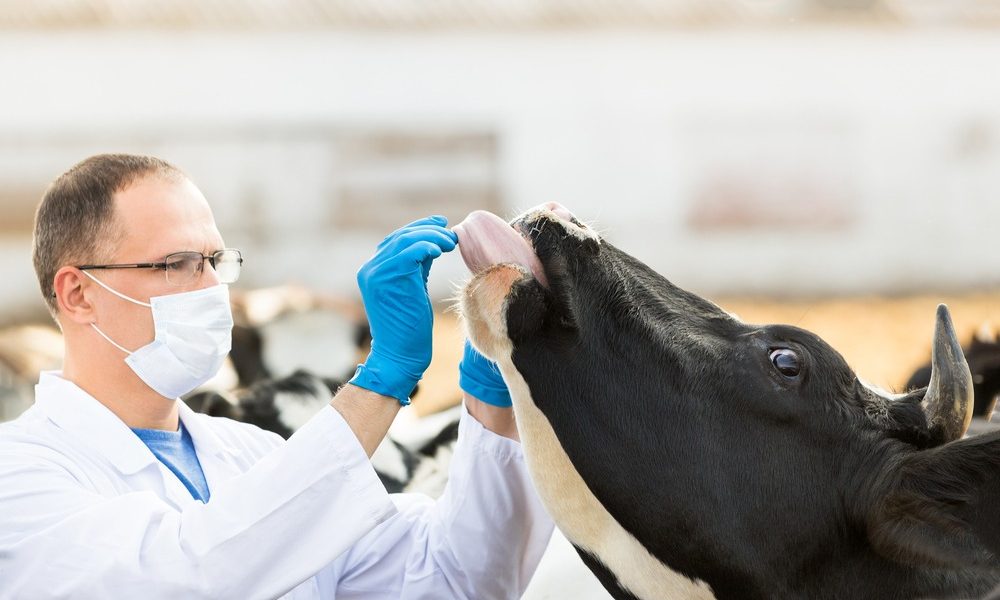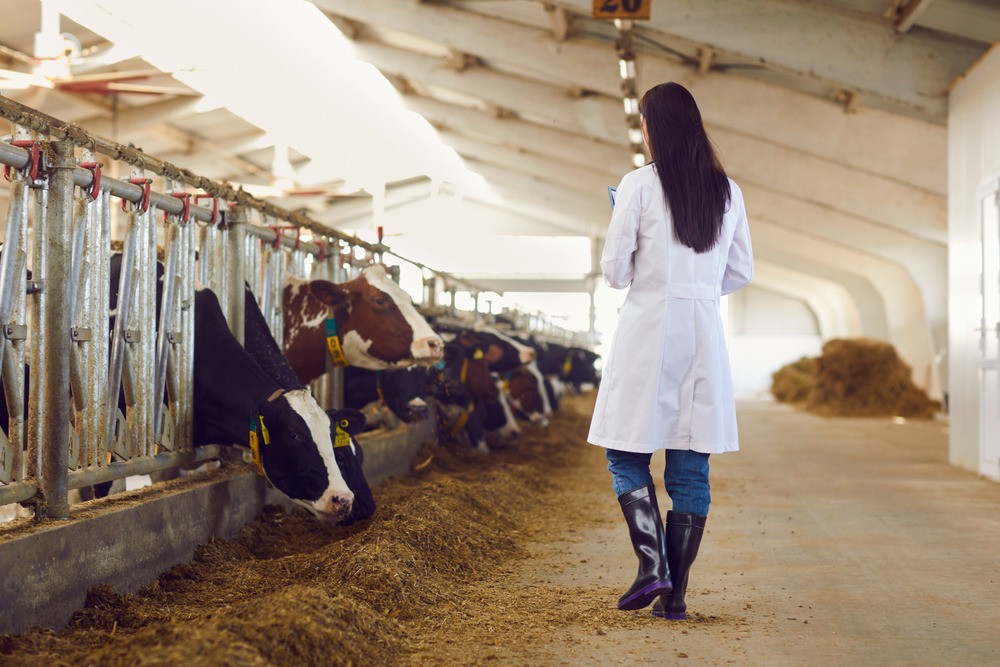Vet Tech Revolution: How LFTs are Changing the Game

What Are Lateral Flow Tests?
Enabling Rapid Disease Diagnosis
Decentralised Point of Care Diagnostics
Fertility Monitoring: A Well-Established Use of LFTs
Powerful Zoonotic Disease Surveillance
Advantages of LFTs Over Other Diagnostics
The Future of Veterinary Diagnostics
Key Takeaways
In this blog Abingdon Health’s Chief Technical Officer, Nina Garrett, provides her perspective on the role lateral flow assays are playing in revolutionising animal health diagnostics.
In recent years, lateral flow tests (LFTs) have emerged as powerful tools in the field of animal health diagnostics, revolutionising the way we detect and manage diseases in animals. These accessible and cost-effective tests have found widespread application across the veterinary sector, providing rapid and reliable results to animal healthcare professionals.
This article dives into the many advantages of using lateral flow tests in veterinary settings that help animals survive and thrive.
What Are Lateral Flow Tests?
Lateral Flow Tests (LFTs), commonly known as rapid tests or immunochromatographic assays, are rapid diagnostic devices that use sponge-like capillary action to detect the presence or absence of a target analyte. The sponge, or nitrocellulose membrane, allows the progression of the sample through a perfect combination of conjugates, capture reagents and buffers to display whether the analyte – or biomarker – is present within minutes. In the veterinary world, these tests can detect a wide range of biomarkers, including infections, hormones, and specific antibodies or antigens associated with various diseases. There is a very informative video on our website explaining in more detail how lateral flow technology works, if you’d like to know more.
Enabling Rapid Disease Diagnosis

One of the biggest game-changers in animal health is the use of lateral flow tests (LFTs) for rapid detection of infectious diseases. These diagnostic tests play a crucial role in identifying pathogens fast; for example, tests exist for canine parvovirus, feline leukaemia virus, bovine tuberculosis, and avian influenza. Much like the COVID-19 response, use of rapid LFTs allow vets and other experts to make swift decisions about isolation, treatment, and prevention strategies within minutes rather hours or days. This can be crucial in containing outbreaks and protecting animal health. And it’s not just vets; farmers, conservationists, zoologists, and even pet owners can conduct tests confidently in various settings with minimal training, from clinics to the field or even at home.
Decentralised Point of Care Diagnostics
Taking samples and sending them to the laboratory is a thing of the past for many indications as lateral flow tests are designed to be simple and user-friendly, making them ideal for Point of Care (POC) diagnostics. Vets and other animal healthcare professionals can perform these tests in-house or in-field, eliminating the need for – and cost of – sending samples to laboratories, while slashing wait times for accurate results. This is invaluable in emergencies or situations demanding immediate action, and for professionals looking to allocate resource (time and money) into other areas, without compromising on accurate diagnoses. Major animal health players such as Zoetis, with their vetscan Rapid, and Idexx’s SNAP tests, have established lateral flow test ranges to allow this decentralised testing.
LFTs also create opportunities for regular wildlife health monitoring, particularly where samples can be obtained and tested without having to disturb the animals. On-site teams can use this data to collaborate with specialist vets, eliminating the need for time-consuming animal tracking and challenging travel to remote locations. Global conservation programs have benefited from the use of lateral flow testing through:
- Population health assessments: providing real time data to support vaccination programmes, habitat management and threat identification.
- Protecting endangered species: tracking and managing diseases before populations are decimated.
- Curbing wildlife trade risks: monitoring infections to prevent spread, support quarantine, and minimise transmission between wild and captive animals.
- Real time conservation data: live population health information guiding vaccination programs, habitat management, and threat identification.
Lateral flow tests are playing a vital role in empowering both vets and conservationists to safeguard animal health worldwide.
Fertility Monitoring: A Well-Established Use of LFTs
Whilst the use of LFTs in the management of infectious diseases is well understood and set to continually evolve – more on that below – another area in the animal health market where LFTs are well established is in reproductive management. From farm animals to endangered species, these tests provide a quick and convenient way to confirm or rule out pregnancy and monitor hormone levels; helping assess reproductive health, monitor fertility and pregnancy, and optimise breeding strategies for optimal chances of success. On-farm lateral flow pregnancy tests are well established; and we have also seen the technology used to monitor endangered species. Pregnancy testing of rhinos is an interesting example of the use of lateral flow tests. Determining pregnancy in these gentle giants can involve sedation, often with risky consequences. However, analysing faecal samples allows for pregnancy checks in the wild using LFTs, without disturbing the animals, supporting conservation efforts while minimising risks and animal distress.
Powerful Zoonotic Disease Surveillance
Not all animals need fertility support though, with there being over 20 quintillion animals on the planet today – that’s 20 billion billion! – interacting with humans regularly. With this amount of interaction, and with it expected to increase particularly with wild animals as their natural habitats grow smaller, the possibility for diseases to jump from animals to humans poses a significant risk to public health, as we witnessed during COVID-19.
Veterinarians now have powerful tools like lateral flow tests available to quickly identify infections that could threaten both animal populations and human health. This proactive approach is essential for early detection and preventing the spread of diseases – and possible outbreaks – with the potential to impact entire communities to safeguard public health. We are seeing innovation in the detection of human diseases through LFTs, but what isn’t as commonly known is the continued investment in developing animal disease detection; a vital surveillance and defence tool.
One such example is the monitoring of avian influezna outbreaks in wild bird (and poultry) populations. Interestingly, in 2023 the Canadian Government issued a call for lateral flow tests for avian influenza to allow in-field testing to speed up early detection of the disease to help control and stop the spread.
Advantages of LFTs Over Other Diagnostics
Lateral flow tests can be easily and effectively used in a wide range of settings, including remote areas and those where resources are limited, offering several advantages to veterinary medicine:
- Speed and Efficiency: results in minutes not days, enabling swift decision-making and speedy interventions.
- Cost-Effectiveness: rapid tests are far more affordable than traditional testing methods, making them more accessible for wider use, including high-volume testing scenarios and in resource-limited areas.
- Convenience: lateral flow tests are stable, compact, lightweight and portable, enabling testing and real time data collection / analysis by anyone, anywhere.
- Minimal Barriers to Market: approval pathways are simpler than human-use LFTs, making development processes for veterinary tests easier, cheaper and quicker without compromising on quality.
The Future of Veterinary Diagnostics
Innovation is driving the expanding use of lateral flow testing in the animal health market. One area of growth is the combining of molecular techniques, such as isothermal amplification with the use of lateral flow strips to measure the result. It’s worth reading Abingdon’s recent blog on this: Combining Molecular & Lateral Flow: A Game Changing Innovation?
In “Development of a multienzyme isothermal rapid amplification and lateral flow dipstick combination assay for bovine coronavirus detection” Chengyuan et al highlight one such application of this hybrid approach. The approach is also being used in companion animal medicine. For example, for testing canines for babesia with lateral flow dipsticks in the paper by Onchan et al.
Innovation in lateral flow materials and techniques is also expanding the use of rapid testing. Use of nanoparticles is a good example of how innovation is driving change in the animal health testing market. Manhas et al provide a good insight into the use of nanomaterials in driving product innovation in the poultry and livestock testing market.
Furthermore, the integration of lateral flow with other technologies such as Artificial Intelligence is also driving improving testing and opening up new market opportunities. Lateral flow testing becomes one of a number of data sets that can collected, analysed and interpreted by AI in real time to provide accurate specific results and predictive models. Whilst not lateral flow testing it was interesting to note Zoetis’s launch in January 2024 of Vetscan Imagyst® AI Urine Sediment analysis, a sign of things to come…
Ultimately, LFTs are a powerful tool in the animal health kit, offering swift, reliable diagnoses. As we start to see more LFTs – across all industries – integrate with digital platforms and enhanced multiplexing capabilities, we are set to see LFTs become more powerful to users; with an improvement in accuracy and faster, smarter results, leading to better outcomes.
Key Takeaways
Lateral flow tests have the power to transform animal healthcare for the better and their use in the veterinary space marks a significant leap forward in the way we diagnose and manage diseases in animals, and safeguard public health. From identifying disease early to monitoring crucial reproductive health, these rapid tests are making animal health diagnostics more efficient and accessible. As technology and research continues to evolve, the future holds promising developments in LFTs that will further protect the health and wellbeing of people and animals, and a healthier world for all.
With the right R&D future focus from academic institutions, industry leaders, and veterinary professionals, supported by expert lateral flow test CROs and CDMOs like Abingdon, we have the power to maximise the technology’s potential benefits to animals and communities the world over, contributing to protecting endangered species, keeping pets healthy, and ensuring food security and quality in animal husbandry.
Abingdon Health have established effective processes that ensures efficient and cost-effective development, technical transfer and scale-up of LFAs. Abingdon is ISO 9001 and ISO 13485 certified and adheres to Good Manufacturing Practise. This framework ensures that developed tests are manufactured in a consistent and robust manner batch in, batch out. Contact the Abingdon team to see how we can help take your test from R&D into reliable manufacture and commercial success. Also, discuss our value-added services such as regulatory and commercial support that provides a de-risked and streamlined route to market.

